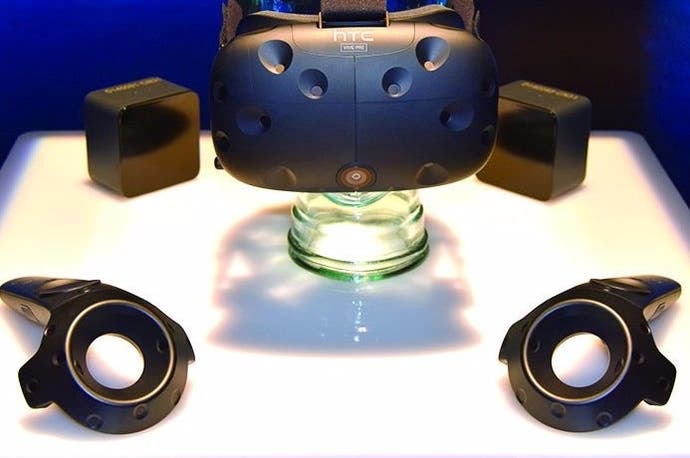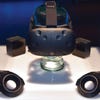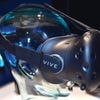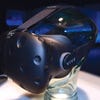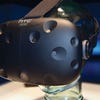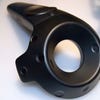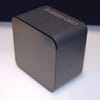Digital Foundry: Hands-on with HTC Vive Pre
Valve and HTC's production SteamVR hardware comes into focus.
This week, Valve hosted the SteamVR Developer Showcase in Seattle, with 12 separate games demonstrated running on the latest Vive Pre hardware. We were invited along, the event consisting of a full afternoon of demos running in sequence - 15 mins on a particular demo, followed by 15 minutes to gather thoughts and write notes. Suffice to say that putting together an article with so much source content is going to take some time, but we can kick off with some observations on the latest revision of the hardware itself - said to be very, very close to final production product.
The last time we at Digital Foundry had access to Vive was at GDC 2015, where a prototype device was set up in the Valve booth, combined with early controllers, which were wired at the time. The sense of being 'strapped in' to the experience was quite overwhelming, but once the headset was moved into place, what became clear was that this was the premier VR experience - absolute consistency in the frame-rate, class-leading image quality and of course, mobility: Vive gave you the ability to explore VR in a way that its competitors didn't.
Almost one year on and much has changed. One of our crucial issues with the hardware has been addressed: back at GDC 2015, I was unable to use the headset while wearing glasses, a difficulty I also experienced with Oculus' Crescent Bay prototype (PlayStation VR was fine). It can be a tight fit at times, but the Vive Pre works just fine in this regard. On top of that, the panel in the headset also appears to have improved - I couldn't quite put my finger on what made it better, but speaking to developers, I understand that the panel is brighter and has fewer motion blur issues. What was already a rock-solid experience now looks even better.
Despite the impressive 1080x1200 resolution per eye, the virtual reality experience still has a slightly blurry, low resolution look to it, and it is still possible to discern individual pixels on the OLED panels. Consciously focus in on them and a screen-door effect is noticeable. However, in general gameplay, the sheer experience trumps these issues and obtrusive pixel-popping aliasing didn't manifest to any noticeable degree in any of the demos I played. There are also no issues with stereoscopy - it just works, providing a very natural view. Depth perception in particular is flawless, and this is crucial bearing in mind that the vast majority of the demos I played utilise the Vive controllers as virtual hands in the VR world, and interactivity is key to many of the experiences.
One issue that won't be solved in first-gen hardware concerns that thick cable that connects the rear of the HMD to your PC. Vive's functionality - supported by many of the games on show at the showcase - allows for full 360-degree mobility around a VR environment. In many cases, I did find my feet bumping into the cable, causing some concern - and I saw another journalist trip, pulling the cable from the breakout box connected to the PC (Vive requires HDMI 1.3 and twin USB 3.0 ports). Developers on-site acknowledged the issue but said that generally, you tend to get used to the cable and work around it.
Vive's SteamVR controllers
The HTC Vive comes with two controllers, monitored in 3D space by the satellite lighthouse positional trackers. They're a curious shape, reminiscent of Star Trek TNG phasers. Principle interaction is via motion tracking, with various buttons - the main trigger, side-mounted 'grip' buttons (activated by squeezing the controller) and two more buttons that sit above and below a highly sensitive touch-sensitive circular pad that is used for more granular in-game interaction. Rumble-style functionality is built into the controller.
During the games we tested, the controllers worked brilliantly both as surrogate hands in titles such as Fantastic Contraptions, The Gallery: Call of the Starseed and Job Simulator, and as FPS weapons in Space Pirate Trainer, Arizona Sunshine and Hover Junkers.
Most of the developers on-site at Valve's event are working on cross-platform VR projects, with Unity as the engine of choice (11 of the 12 games showcased ran on the same middleware platform). All but one of those 11 require 3D capable interfaces, and there was a great deal of concern about the lack of in-the-box Oculus Touch controllers. There are ramifications for Sony too: will PlayStation Move remain an optional purchase when a 3D controller is so crucial to so many VR titles? The Vive controllers were said to be far more accurate than PlayStation Move, a strong endorsement bearing in mind how precise Sony's 3D controller is.
The lighthouse family
The final component in the Vive set-up concerns the twin 'lighthouse' boxes used for positional tracking of the headset and the controllers. These components are the key to Vive's full 360-degree tracking - placed at diagonals in the playspace, structured light lasers sweep the area, ensuring full coverage at all times. This gives Vive a key advantage over both Oculus Rift and PlayStation VR - both of those solutions use a single camera placed directly in front of you. This is fine for many (if not most) applications, but for games requiring full movement in the 3D space, the controllers can't be tracked if they cannot be seen by the single camera, leading to an immersion-breaking experience.
This may well be an issue for certain titles - such as Job Simulator. In the demo we played, set in a kitchen, players use the 3D controllers to grab utensils, ingredients and appliances from around the virtual environment, including behind you. Hover Junkers, a vehicle-based FPS shooter, sees you steering the vehicle and blasting opponents by physically turning to face in the direction you want your junker to travel in. For PSVR and Oculus, the developer is considering moving vehicle rotation to the controller in order to overcome the occlusion issue.
The inclusion of the lighthouse boxes and the 3D controllers will undoubtedly add to the cost of entry for the Vive hardware, but Valve's strategy here is straightforward and logical - it has created what it considers to be the most flexible, feature-rich VR hardware solution. The cost of the device is clearly less important at this point than getting the core feature set right. Even at this early point, it's clear that Vive has functionality options that Oculus Rift and PlayStation VR do not have - in effect, the competition operates with a subset of Vive's functionality.
Perhaps the biggest surprise of the SteamVR event was the extent to which 'room scaling' - full 360-degree movement around the playspace - was embraced by the attending developers, even though this may cause issues for Oculus and PSVR ports (not to mention the requirement for a decent-sized area of movement in the player's environment). But it does make a genuine difference to the VR experience, particularly in terms of titles with a strong exploration element, such as Budget Cuts and The Gallery: Call of the Starseed.
As things stand, the HTC Vive hardware defines the VR experience that Sony and Oculus need to match - the GDC 2015 showing propelled the system to the front of the three competing systems, and the near-final offering in the form of the Vive Pre shows refinement in all the right places: comfort, quality and control.
Beyond the basics, its key strength is how seamless and complete the experience feels - at no point through any of the 12 demos did we lose positional tracking from the headset, nor were the controls anything other than totally rock-solid. And as we'll cover soon, the games are very cool too. The experience still needs to be tested outside of controlled conditions, of course, but all the indications so far strongly suggest that SteamVR and HTC Vive are ready for showtime.
The HTC Vive Pre hardware was revealed to journalists at Valve's SteamVR Developer Showcase in Seattle, which we attended. Valve paid for travel and accommodation.
